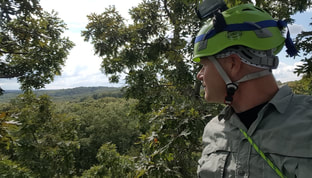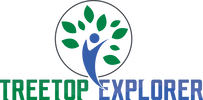 There is a sensation you get when sitting at the top of a tree, looking out across the tops of the surrounding trees and forest canopy. Taking a look down to the ground below, your body buzzes from the excitement of knowing you are in a special place. A place very few people get to visit. You have climbed to the top relying solely upon your own ability and determination. You have distanced yourself from the stressors of your day, quieted your mind, and can begin to reconnect with yourself. Some of these experiences leave a lasting impression. I can close my eyes and transport myself back to specific experiences: sitting on a branch at the top of a 200’ redwood, inhaling the scent of the needles atop a 110’ eastern white pine, and watching storm clouds move in the distance from my perch near the top of a 55’ white oak. Recreational tree climbers enjoy these types of experiences regularly, often searching out trees that provide the opportunity for a unique experience. How High Can You Climb One of the most common questions I am asked is whether I have climbed a redwood. The assumption being that the higher the climb the more enjoyable it is. My experience at 200’ was memorable and I do enjoy opportunities that allow me to climb higher than I have been before. For some people, climbing high is energizing. For others, frightening. There is great variance in the height at which each person feels is high enough for them. If you have climbed ladders, towers, or trees, you were likely aware of the stark differences between being at 15 feet and at 40 feet. When secured by a rope and safety equipment, the height at which you are comfortable climbing to is likely to increase. If you are looking for height, then you’ll obviously want to search out the tallest trees that grow in your area. Eastern cottonwood and eastern white pine are two species that can reach over 100 feet in Wisconsin. Even if you are not able to find a suitable tree for climbing to these heights, there are other ways to enhance the sensation of increased heights. This can be done by climbing trees on hillsides, ridgetops, or atop a bluff. Once you leave the ground, your perception of height is relative to your point of view. For this reason, if your climbing tree is situated higher than the landscape in your field of vision, you will experience an enhanced sensation of your height relative to the ground directly below you. While height is part of what makes climbing trees exciting, it is only one aspect of what tree climbers enjoy about climbing.  Out On A Limb Since trees are 3 dimensional, for many climbers the joy of a climb lays more in the branching characteristics of the tree. They search for trees that have a lot of large branches that spread out over a large area. When growing in full sun, oaks, maples, and others tend to develop a broad-spreading crown. This type of branching structure provides opportunities to maneuver around the branches. This shape also allows the challenge to walk on branches and traverse from one side of the tree to the other. Lateral movement across the crown of a tree requires additional skills and techniques then what is used when climbing a tree with a strong central trunk like a pine or spruce. Stimulate the Senses If you are familiar with aromatherapy and its ability to promote health and well-being, you are likely to understand why climbers may spend an afternoon in the branches of a spruce tree. The essential oils industry is very much aware of the beneficial properties of trees considering the number of tree oils available. With some climbs, my sole intent may be to head up to where I can find a branch to lay back on. With eyes closed, my body is tuned into the movement of my branch as the tree responds to the breeze. Your sense of balance falls into this rhythm in much the same way as when the waves gently sway your boat on open water. When a tree with nice horizontal branches cannot be found, a hammock can provide a comfortable place to rest high in the branches. Close your eyes and you will find it easy to drift off to sleep.  Bark texture varies widely between types of trees. American beech has smooth bark, bur oak is rough, and white cedar bark is soft and fibrous. Not only can you enjoy the different textures by running your hands across the bark, but the atmosphere within the tree canopy varies in a similar manner as the ambience between rooms with hard wood floors, tile, and carpeting. Let’s not forget the mighty tree itself. You may be drawn to a tree simply because it catches your eye and inspires you to venture upward in search of the pleasures it holds. Often times the trees we are climbing are much older than ourselves by a hundred or more years. They may have been planted by a relative a few generations back. Trees hold a history of changes they’ve seen in the area around them. If you sit in the branches long enough, you may be able to find connection and heightened awareness of your place in time. Given the number of experiences and reasons you may have to climb a tree, the best climbing trees might be found in your back yard, a nearby park, or along a river in a remote woodland area. The number of experiences that await in the branches above are endless. All are exciting in their own way. You just need to decide how you want to spend your time and find a tree that is suitable for the experience.
2 Comments
|
AuthorAs a G.O.T.C. Recognized Master Instructor & Facilitator, I.S.A. Board Certified Master Arborist, and T.C.I.A. Certified Treecare Safety Professional, Curt has spent over 30 years dedicated to the study and care of trees. Categories
All
Archives
May 2024
|
|



 RSS Feed
RSS Feed
